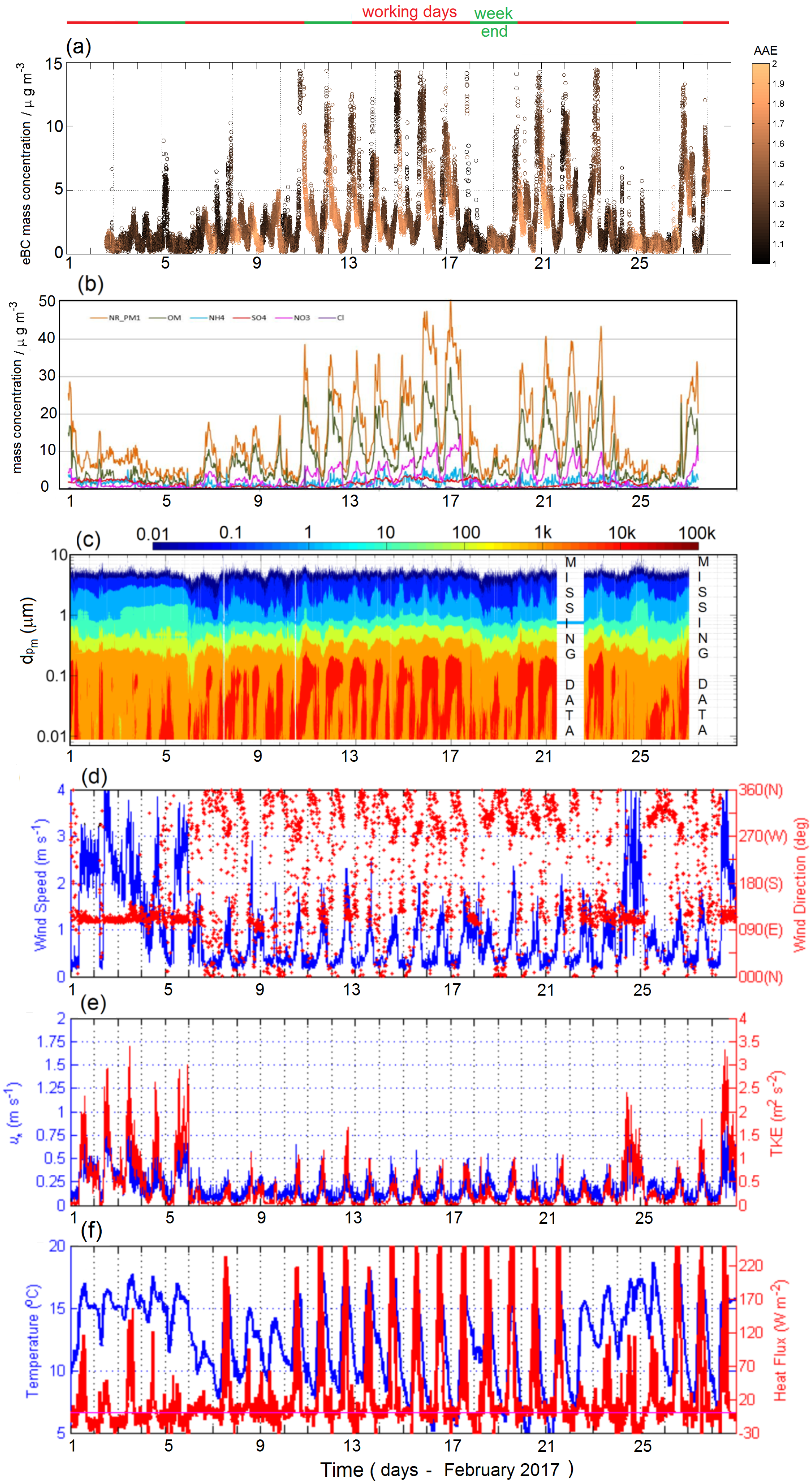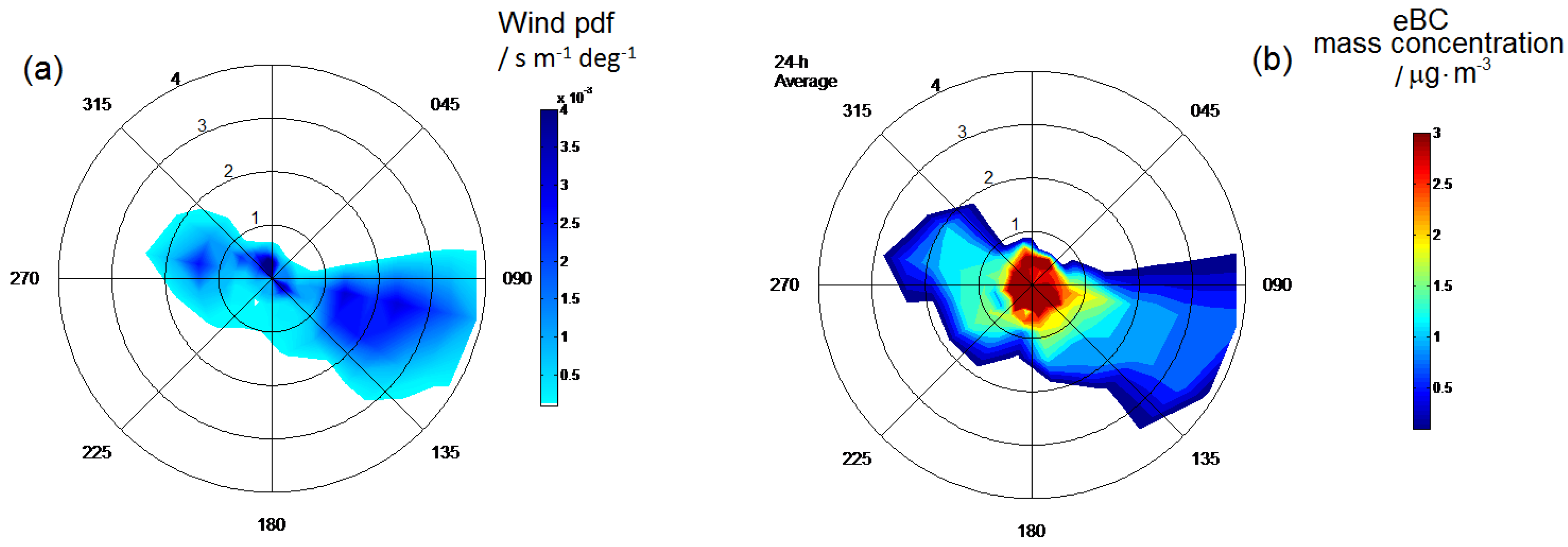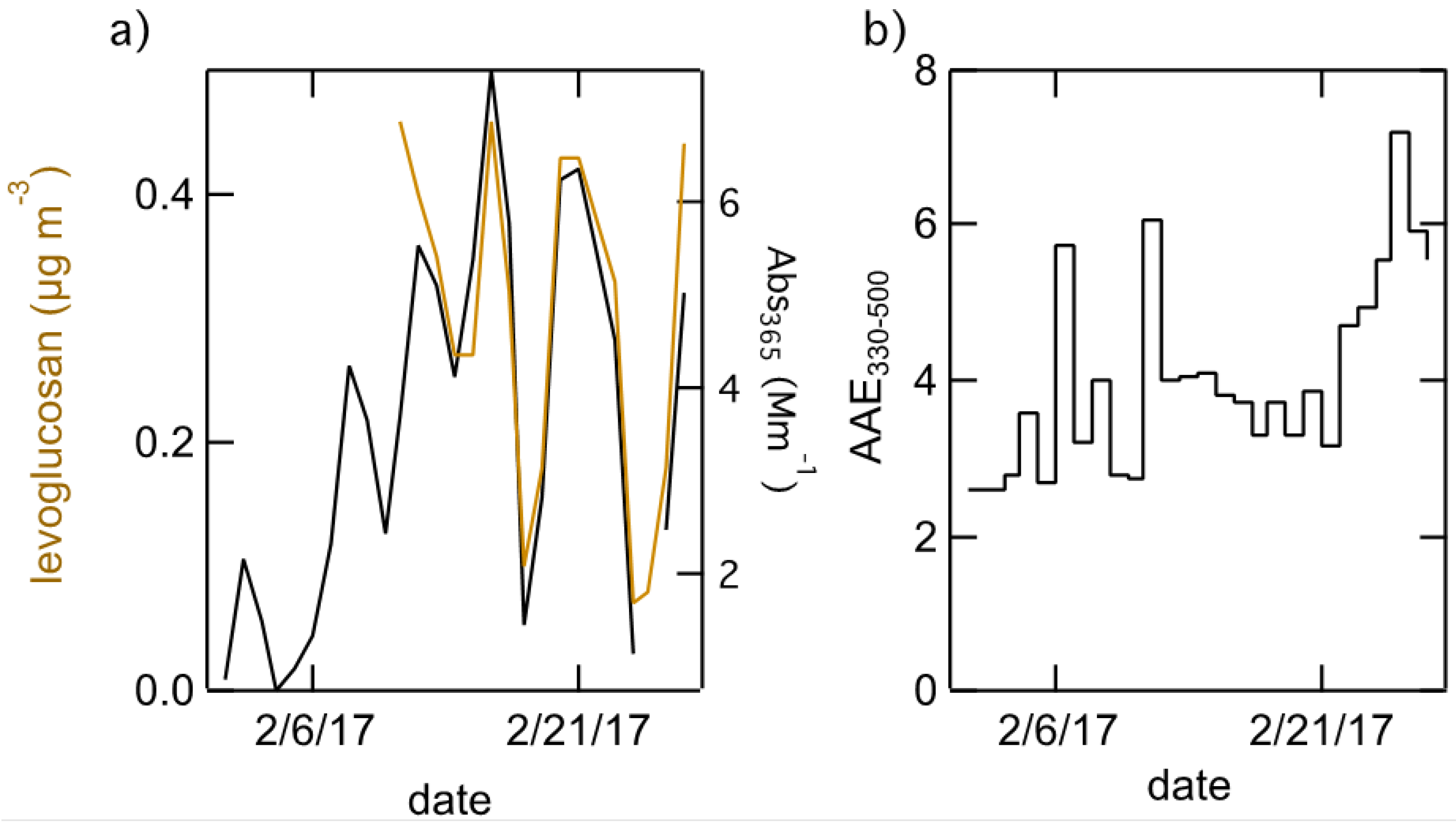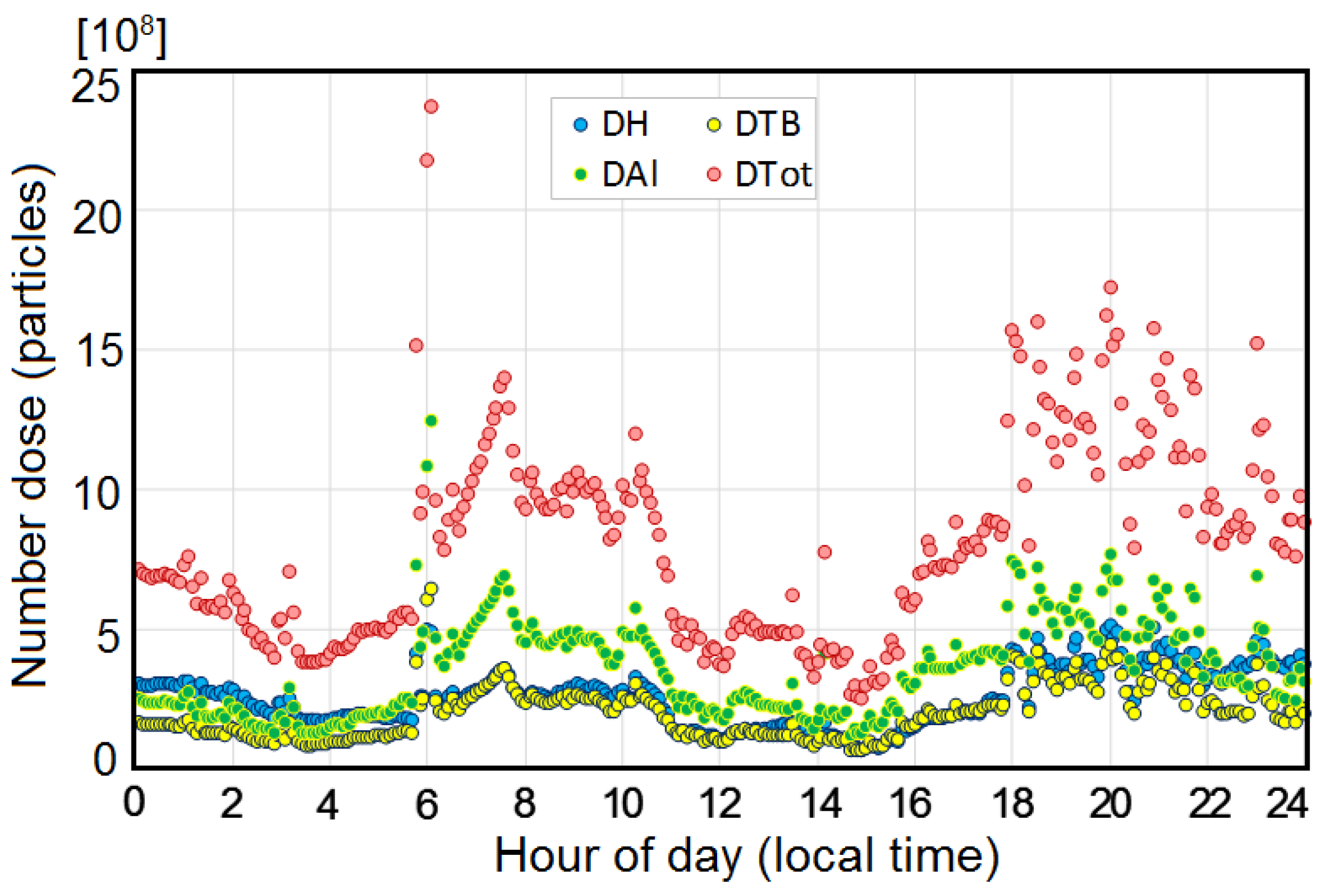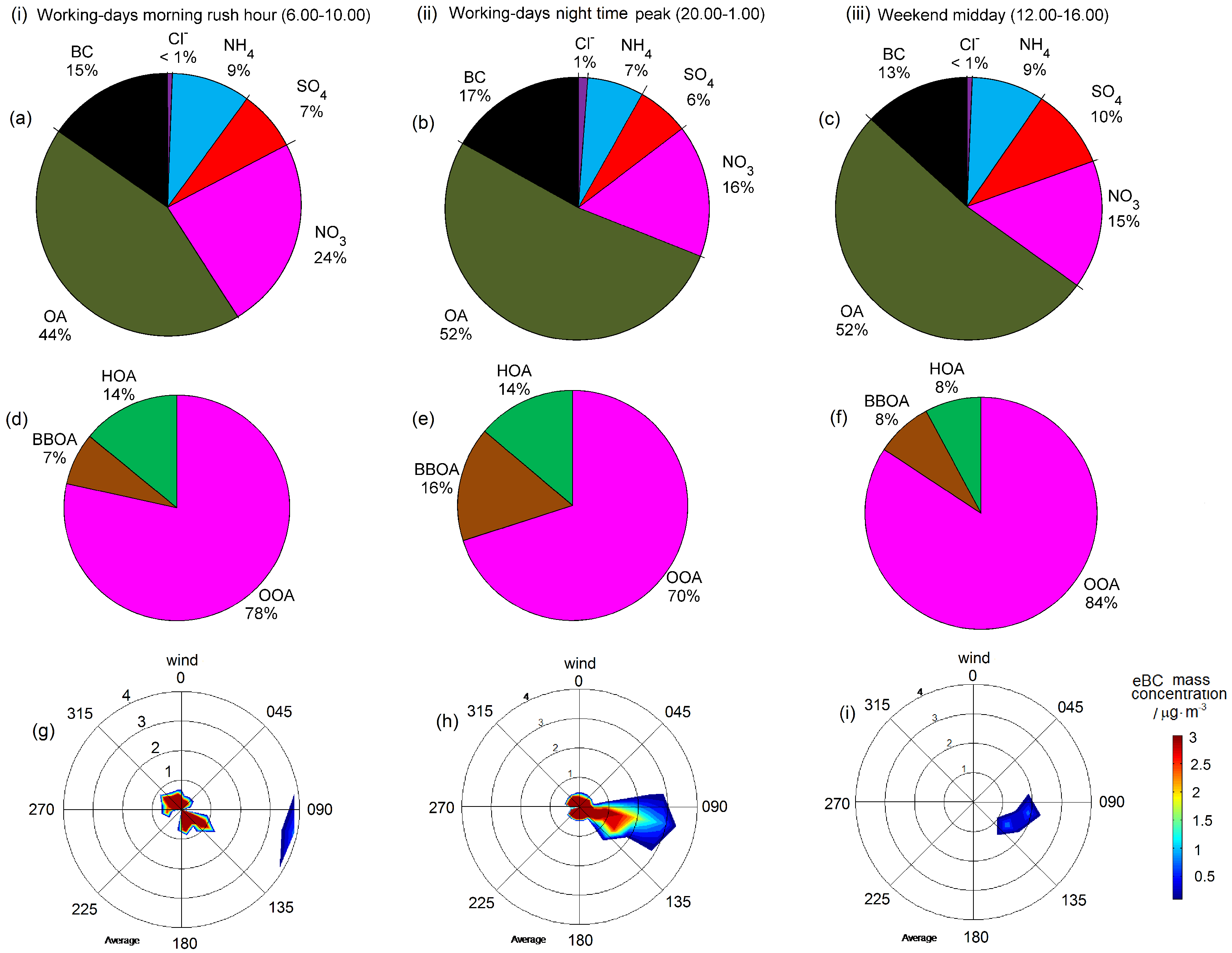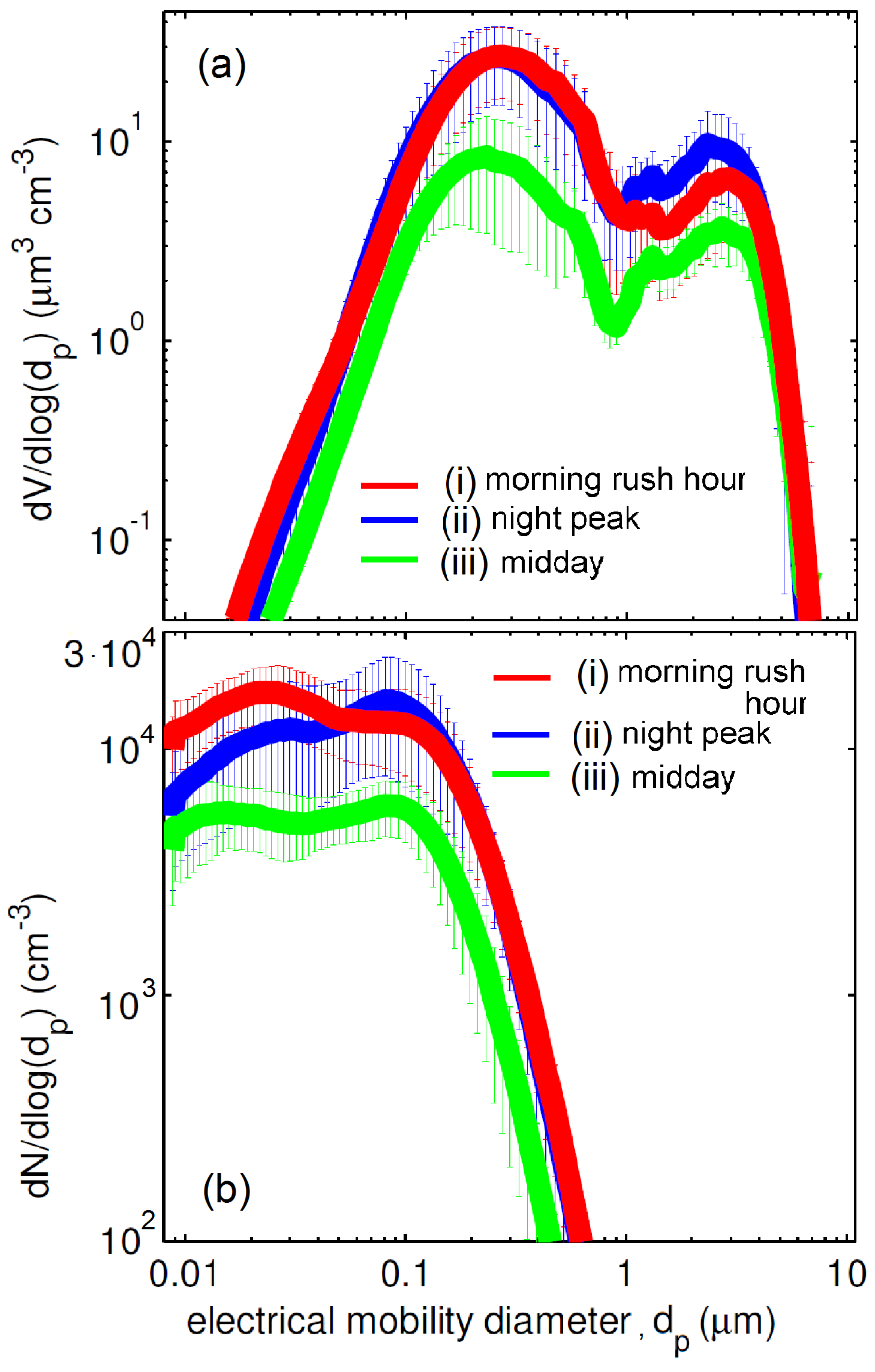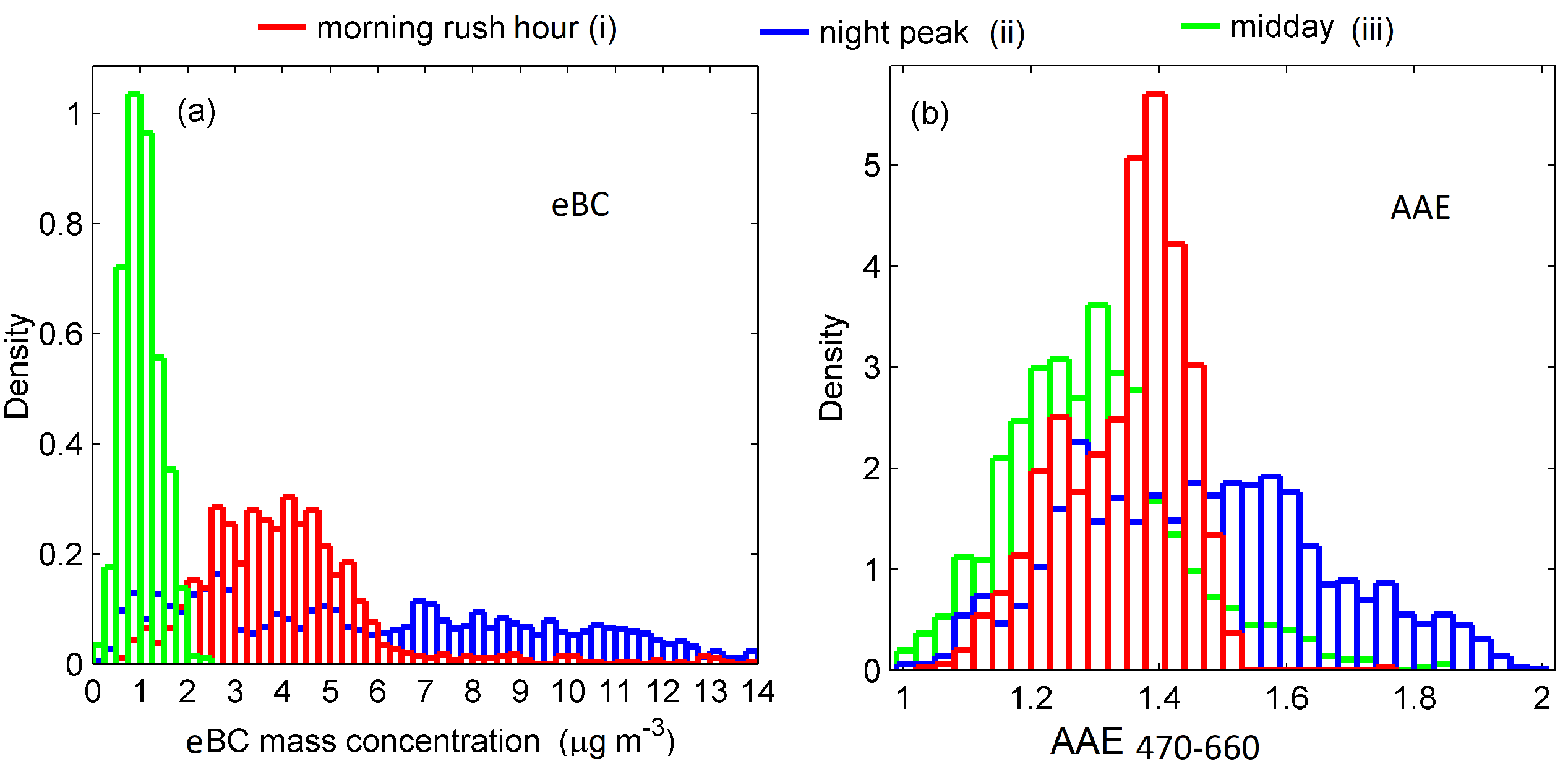1. Introduction
There is evidence that ambient particulate matter (PM
and PM
) pollution poses severe risks to the human health [
1,
2,
3,
4,
5,
6,
7,
8,
9,
10]. This has led governments to adopt air quality standards for PM
and PM
. PM
is a heterogeneous mix of solid and liquid particles of different sizes (from few nanometers to 10
m) and different composition (including carbonaceous material, trace metals, crustal material, nitrates, sulfates, sea salt, ammonium). The specific aerosol types responsible for health effects, among those constituing PM
, remain uncertain, and no safe level for the exposure to PM
and PM
has been found [
4]. This has sparked the debate over the need to update these standards.
The carbonaceous aerosol has been suspected to be more toxic than other PM
constituents [
2,
4,
7,
11]. In their modeling exercise to assess the contribution of outdoor air pollution sources to premature mortality on a global scale, Lelieveld et al. [
2] considered the carbonaceous PM
as five times more toxic than inorganic particles. It is not clear if carbonaceous aerosol health effects are due either to its chemical composition (as elemental carbon particles or as carrier of other organic and inorganic chemicals) or to its physical properties (particle size, number and surface area) [
1,
3,
4,
7,
8,
9,
10]. The carbonaceous aerosol is mainly found in submicron atmospheric aerosol particles, and most of these particles are in the ultrafine particle (UFP) size range (diameter less than 100 nm) [
12]. Toxicology of UFPs is an emerging discipline because the size of these particles facilitates both adverse health effects in the lung and effects extending beyond the respiratory tract. Evidences have been found between short-term exposures to UFPs and the cardio-respiratory health (no matter what the particle composition is) [
4]. Associations between ultrafine particles and the health of the central nervous system have also been reported. Inhaled ultrafine particles may translocate to the brain [
13] where they can cause adverse impacts by inflammation and oxidative stress, which are common mechanisms similar to those acting in the lung [
14,
15]. Recent cross over studies on UFP and daily mortality in Europe, however, still show contrasting results and question the lack of a standardized protocol for UFP data collection [
16].
The carbonaceous aerosol in the atmosphere comes as a complex mixture of aerosol types. Major components are black carbon (BC), organic aerosol (OA) or organic carbon (OC), and brown carbon (BrC). These are always internally or externally mixed with other components. BC and BrC are carbonaceous aerosols in their chemical composition, but are named after their light absorption properties: BC because it looks blackish, BrC because it looks brownish. The size of these particles span from a few nanometers to a few micrometers. Relevant microphysics (size, mixing state, number) constitute one of the greatest uncertainties in both models and observations [
17]. Importantly, no reference method has been developed yet for measuring the carbonaceous aerosol. In particular, there is no an accepted standard to measure BC [
18]. Thermal-optical methods combined to chemical methods have traditionally been used to measure EC and OC, although drawing a clear border between organic macro molecules of OC and small clusters of possibly amorphous EC is challenging [
18]. Spectral optical methods have traditionally separated BC from the bulk aerosol, while more recently BrC has been connected to the wavelength dependence of light absorption [
12]. Recent development of single-particle instruments capable of detecting BC (i.e., the single-particle soot photometer, SP2) has provided a method to obtain number size distributions and mixing state of refractory BC (rBC), although the particle size range is very limited (80–300 nm). Significant steps forward in the OA characterisation have been made in recent years thanks to the use of field-deployable, high-resolution, time-of-flight aerosol mass spectrometers [
19].
Carbonaceous aerosol levels in Europe are still uncertain, and certainly largely variable across the different regions [
20,
21,
22,
23]. Cavalli et al. [
22] suggested that the atmospheric concentrations of PM
and PM
carbonaceous constituents increase when moving from Scandinavia to Central Europe towards the Mediterranean. The Mediterranean basin, characterized by low cloudiness and high incoming solar radiation, is indeed an area of particular sensitivity as far as air pollution and climate change are concerned, e.g., [
24]. Modeling results by Lelieveld et al. [
2] show that the mortality linked to outdoor air pollution (mostly by PM
) in this region would definitely not be low, and that Italy would rank 18 among the countries with premature mortality by PM
and O
related diseases. As per Lelieveld et al. [
2]’s results, land traffic would be one of the source categories responsible for the largest impact on mortality in the European Countries around the Mediterranean. In urban areas of Southern Europe the relative contribution to carbonaceous aerosol from vehicle exhaust could be more significant than that of other sources—e.g., biomass burning from domestic heating [
21,
23].
In this paper, we present first results of carbonaceous aerosol measurements carried out in February 2017 in Rome. The aim of this paper is to provide baseline levels of carbonaceous aerosols for the urban area of Rome reducing the assessment uncertainties of aerosol optical, chemical and microphysical properties, and to address future research and policy directions. Measurements were carried out in the framework of the experiment entitled “Carbonaceous Aerosol in Rome and Environs (CARE)”. As the present paper is the first of more detailed papers about the results of this experiment, here we briefly describe the general idea and methods of the whole project. The CARE experiment addresses the following specific question: what is the color, size, chemical identity, and toxicity of BC and BrC in the urban background of Rome? To this end, a robust dataset of optical–microphysical–chemical properties of the carbonaceous aerosol was collected, together with toxicological data to characterise relevant human health exposure. Different techniques for measuring carbonaceous aerosol properties were coupled with the aim to improve data reliability. Number size distribution (0.008–10 m), composition (EC, OC, and major components of nor-refractory PM), mass concentration, and wavelength-dependent optical properties (BC and BrC) of the bulk aerosol were measured at a fixed location in the downtown Rome with high-time resolution (from 1-min to 2-h). 24-h measurements of PM and PM mass concentration, EC/OC, Water Soluble OC (WSOC), and water soluble BrC (WSBrC) and levoglucosan were carried out at the same site. Mobile measurements were carried out to assess the spatial gradients of BC particles near urban roadways and building surfaces, and the connections between these gradients and the atmospheric turbulence will be assessed through Computational fluid dynamics modelling (CFD). Typical road dust loadings and emission factors due to traffic resuspension for PM and EC/OC were quantified with the aim to obtain the chemical profile of road dust emissions (only thoracic fraction) to apply in receptor modelling to quantify road dust contribution to PM, OC and EC concentrations. The toxicological assessment included the preliminary evaluation of the potential impact of ultrafine particles on lung epithelia performed by directly exposing BEAS-2B cells to air pollution. Cells were cultured at the air liquid interface and exposed to particles by using the Culltex RFS-1 module. Finally, the oxidative potential associated with carbonaceous aerosols was assessed (2-h time resolution), particle size dependent number doses deposited in different regions of the human body was modeled, and biomonitoring of polyaromatic hydrocarbons (PAHs) was performed.
4. Discussion
Here we discuss preliminary results of the CARE experiment presented in
Section 3. First, we compare aerosol measurements to values measured across other European locations (
Section 4.1). Then, we discuss the data averaging period used in current air quality standard for PM
(24-h) by looking at peak values of carbonaceous aerosol properties (
Section 4.2 and
Section 4.3). Third, we speculate on possible toxicological implications (
Section 4.4). Conclusion and future research and policy directions are given in
Section 5.
4.1. Black Carbon in Rome Compared to Other European Cities
The aim of this section is to compare the data measured in Rome to data available for other European cities. This is explored in
Table 7.
First,
Table 7 points out that the levels of eBC and EC mass concentration are similar at the CARE site and at two other urban background sites in Rome: these data were measured (with similar instrumentation) during three different field campaigns in different years (2005, 2013, 2017 CARE, [
74,
75]). The fact that similar values occur at similar locations (but not in the immediate vicinity) in different years (and different months of the year) allows us to extend the results obtained, and to conclude that these values are representative of the urban background in Rome. The fact that the eBC at the CARE site (a park, more than 100 m away from the nearest traffic source,
Figure 1) was not dominated by a single source is also supported by
Figure 3b showing no influence from a single wind direction to the eBC mass concentration. Also, this is indicated by the MAC
values measured in the CARE experiment (8.6 ± 0.9 m
· g
at 637 nm), which are larger than values expected for freshly generated BC particles (at 550 nm, 7.5 ± 1.2 m
· g
[
12], and thus less at 637 nm). The values reported at suburban background locations in Rome [
74,
76] are lower than values reported at these urban background sites (CARE, [
74,
75]). Combining all these data in Rome (
Table 2,
Table 3 and
Table 7), we draw here the baseline levels for eBC and EC in the urban area of Rome:
the mean value at suburban background sites of eBC mass concentration = about 1
g · m
([
76]);
the mean value at urban background sites of eBC mass concentration in winter = 2.3–2.8
g · m
, and EC mass concentration = 1.9–2.3
g · m
([
74,
75,
76] and
Table 2);
the mean daily maximum (1-min) concentration of eBC at urban background sites during winter = 5–5.5
g · m
(
Table 3).
Second,
Table 7 compares these eBC and EC mass concentration values in the urban background of Rome to values reported in literature at other urban background locations in Italy and Europe (London, Paris, Barcelona, Lugano). The (nineteen) sites in Italy were all classified as urban background sites, and include eight locations in the Po Valley, and one in Rome [
74]. The site in Barcelona was characterized by a very dense road traffic network, one of the city’s main traffic avenues being located approximately 300 m from the site; the Lugano site was in a park in the city center, about 50 m to the east of a busy urban road; the London site was in North Kensington in the grounds of a school in a residential area [
77]. The site in Paris was an AIRPARIF air quality monitoring network site representative of Paris background air pollution [
78]. The values of eBC mass concentration reported at these urban background sites in Paris, Barcelona, London, and Lugano [
77,
78] are lower than the values reported at urban background sites in Rome (CARE, [
75]). The mean EC mass concentration values reported in winter at urban background sites in Italy [
74] are mostly lower (with a few exceptions at Po Valley sites) than values reported at urban background sites in Rome (CARE, [
74]). The monthly average EC in February at different urban background sites in Barcelona calculated from 1999 to 2011 [
23] is lower than the values reported at urban background sites in Rome (CARE, [
74]). Note that the N
was lower in the CARE campaign than in the earlier studies (N
was lower only at a regional EMEP site [
79]). This will be analysed in the future. There can be many possible explanations, and some of them may be partly derived from the instrumentation and measurement standards [
80]: the SMPS was used in CARE, the CPC or WCPC in the earlier studies; measurement were carried out at RH < 30% in CARE (EUSAAR/ACTRIS protocol), and under ambient conditions in the earlier studies.
Finally,
Table 7 also compares values of eBC mass concentration measured at different urban background sites during the case-study periods reported in
Table 3: the rush hour of the working days, and the weekends at midday. The value in Rome is larger than values reported in Paris, London, Lugano and Barcelona [
77,
78]. This issue is discussed further in
Section 4.2 and
Section 4.3, and will be analysed in detail in the future.
4.2. On the Differences between Values at Urban Background and Traffic Sites
The aim of this section is to address differences between values measured at urban background and traffic sites in Rome. During the CARE experiment, additional eBC measurements were carried out while moving from emissions sources (e.g., roads) to parks to residential areas (cf. methodology,
Section 2.3.15). The mobile measurement approach has the ability to capture the spatial variability or heterogeneity of eBC mass concentrations, which is a limitation of fixed stations. Mobile measurements during CARE will be the subject of a future paper. Here we show an example (
Figure 10) of eBC mass concentrations measured during the morning rush hour (8:00–10:00 CET, 20 February 2017) at the CARE fixed station (black line) in comparison to that measured by mobile measurements (red line).
Concentrations measured at intersections with high vehicular traffic, traffic light areas, and along roads with street canyon configuration are significantly higher than those measured at the fixed station. Aside from vehicular emissions, high concentrations of eBC were also found along streets with restaurants using open fire heater for outdoor dining. This was more evident during the evening runs, characterised by lower temperatures and a larger number of open restaurants. Concentrations were found to decrease rapidly to urban background levels when entering traffic-limited regions such as residential, private, and park areas. Lower levels of eBC were also found along roads around tourist sites that are under traffic-limiting regulations.
Similar results were found in every single run performed throughout the campaign—details will be presented in a future publication. This shows that eBC concentrations measured closer to urban emission sources (e.g., at traffic lights) in Rome are much higher than those at the CARE urban background site. Note that peak values during this example (up to 30
g · m
) are two times higher than the highest reported at the urban background site (up to 15
g · m
,
Figure 2a).
4.3. On the Data Averaging Period for the Carbonaceous Aerosol
The aim of this section is to discuss the data averaging period to be used for the carbonaceous aerosol in urban areas. The shorter term EU air quality limit value for PM rely on 24-h averaged data, meaning that all peak values occurring during the 24-h averaging period are considered as equally contributing to the average value. Here we intend to show how different these peak values are (in terms of particle composition, size distribution, and color), and question the appropriateness of using 24-h average for the carbonaceous aerosol.
We analyse and compare three different cases: (i) the week-day morning rush hour (6.00–10.00, LT); (ii) the week-day night peak (20.00–00.59, LT); and (iii) the weekend midday (12.00–16.00, LT). This is explored in
Figure 11,
Figure 12 and
Figure 13 and
Table 3 showing:
major components of PM
(panels a, b, c of
Figure 11),
contributions to the total OA in NR-PM
of the major emission sources identified (Vehicular traffic emission (HOA), Biomass burning emission (BBOA), and Oxygenated secondary aerosol (OOA)) (panels d, e , f of
Figure 11);
wind conditions (panels g, h, i of
Figure 11);
eBC and AAE (as probability density functions, pdf,
Figure 13);
all descriptive statistics (
Table 3).
At the morning rush hour (case (i)) we observe:
HOA contribution larger than BBOA contribution (unlike case (ii),
Figure 11d,e),
the largest NO
contribution to PM
(
Figure 11a),
the highest UFP number concentration and N
(
Figure 4d),
the largest BC-to-PM
and EC-to-OC (
Figure 4f),
higher concentration of aged nucleation mode particles (diameter of 20–30 nm in
Figure 12b) than for case (ii).
In this case (i), we likely measured the (shortly aged) road traffic related aerosol. Unlike case (i), at the night peak hour (case (ii)) we observe:
In this case (ii), the aerosol is probably a combination of different sources differently aged in the atmosphere. At midday case (iii) the aerosol had mass and number concentrations much lower (more than four times lower), and a higher OOA contributions. This case is intended to contrast conditions represented in the cases already described cases (i) and (ii).
Note that the three cases selected (morning rush hour, night peak hour, and midday) are commonly characterized by different atmospheric conditions. This includes different boundary layer dynamics, which also likely play a role in influencing aerosol total concentration. The best dispersion of atmospheric pollutants is observed during the central hours of the day case (iii), with a maximum from 02:00 to 16:00 (cf. diurnal cycles in
Figure 4 and
Figure S23 of the supplementary Materials). During the afternoon, a progressive stabilization of the atmosphere is observed, which lasts until the late morning of the following day, with a maximum at sunrise. This is reflected in the relationship between mass concentration and wind (panels g–i of
Figure 11) for reasons of space, we show eBC only. The larger eBC mass concentrations at the morning rush hour case (i) are caused by the combination of low dispersion, low winds (<1 m·s
,
Figure 11g) and increased local aerosol emissions (mainly from road traffic, according to
Figure 11d). The (very) high eBC concentration at the night peak hour case (ii) have various causes: biomass burning emissions were larger than during the morning hours case (i); wind speeds were often as low as on the case (i) (
Figure 11). The latter situation highlights the role of emissions: by comparing panel h and i of
Figure 11, we observe that the eBC concentration is larger at the night peak hour than at midday, despite the same wind conditions (wind speed of 1 to 2 m·s
from E-SE). Finally, it is worth noting that the eBC mass concentration at the CARE site is not dominated by a single source (
Figure 3b), and that there is no influence from a single wind direction even during the selected case-studies (e.g., the morning rush hour in
Figure 11g).
These findings point to the importance of considering proper time-scales to analyse carbonaceous aerosol properties. These are clearly shorter than 24 h, and the use of a 24-h data averaging period can significantly limit findings. Based on these findings, in
Section 4.4 we will analyse relevant toxicological data with the aim to provide recommendations for acute exposure studies.
4.4. Toxicological Implications
In this paper we presented for the first time to our knowledge the use of an ALI exposure system for the direct exposure of an in vitro system to airborne particulate matter under real environmental conditions. Preliminary results indicate no clear sign of cytotoxicity in cells exposed for 24 h (
Section 3.3.2). The regulation of genes involved in cellular pathways of interest will be evaluated in future. Future analysis will include the assessment of the aerosol number dose deposited in the human body (
Section 3.3.3). Here we reported (
Figure 9) the aerosol number doses deposited in the head (H), tracheobronchial (TB) and alveolar (Al) regions along with the relevant total dose estimated (we show 20 February 2017, the same day as for eBC mass concentrations measurements in
Figure 10). These preliminary results indicate that number doses and deposition in different regions of the body change with time during the 24 h (e.g., rush hour vs. midday vs. night).
Future analysis will couple these data and the aerosol data, to the oxidative potential data presented in
Section 3.3 and biomonitoring data presented in
Section 3.3.4. The aim will be to link carbonaceous aerosol levels in the atmosphere to the real human exposure. Preliminary findings suggest that human exposure to carbonaceous aerosol can be correlated to eBC mass concentrations [
73]. The premise for this exercise will be the increasing awareness that carbonaceous aerosols may induce health effects through the generation of oxidative stress [
15,
81,
82,
83,
84]. The biomonitoring data will provide information on the oxidative stress (
Section 3.3.4), defined as an imbalance between the level of reactive oxygen species (ROS, or free radicals) and the natural antioxidant defence of the biological system. It is commonly thought that ROS can damage lipids, proteins, and membrane DNA, and can also cause cell death by necrotic or apoptotic processes. The oxidative potential (OP) associated with aerosol particles (
Section 3.3.1) is considered as a proxy of the ability of PM
to generate ROS, and is defined as the capacity of PM
to oxidize target molecules. The measurement of the OP was proposed as a possible air quality exposure metric. The relation between the oxidative stress and the OP will be analysed in future studies. Here, we present a preliminary analysis of the OP data.
Considering
Figure 14a, the aerosol occurring at the night peak hour (blue markers) correspond to the lowest values of the oxidative potential and to the highest eBC mass concentration. Conversely, the aerosol occurring at the morning rush hour (red markers) might have significantly larger values of the OP if associated with smaller particle size. Indeed, at the morning rush hour we observed a particle size-dependent OP: the OP tends to increase with decreasing aerosol median diameter (
Figure 14b).
These preliminary findings reinforce existing concerns about the toxicity of carbonaceous aerosols [
2,
3,
4,
7,
8,
11]. We support literature findings indicating that the toxicological risk of carbonaceous aerosol might depend on both particle size and composition (e.g., BC levels). Also, we show that BC toxicity may increase with decreasing particle size, but only for certain conditions—i.e., the morning rush hour case-study, during our experiment. The same does not apply to the night peak case-study, which shows the highest values of the BC mass concentration with small particle size, but has the lowest toxicological effects. Future studies will look into possible causes for these differences, including certain combinations of particle size and chemical composition. Also, a comparative campaign in a contrasting season such as late summer is likely to be carried out.
5. Conclusions
In February 2017, the “Carbonaceous Aerosol in Rome and Environs (CARE)” experiment was carried out to address the following specific questions: what is the color, size, composition, and toxicity of the carbonaceous aerosol in the urban background area of the city of Rome? The motivation of this experiment is the lack of understanding of what aerosol types are responsible for the severe risks to the human health posed by particulate matter (PM) pollution, as well as how carbonaceous aerosols influence radiative balance. To answer these questions, physicochemical properties and toxicity of the carbonaceous aerosol were characterised in the downtown Rome with high time resolution (minutes to hours).
Preliminary findings of the CARE experiment presented in this paper:
Baseline levels for urban background aerosols in Rome were determined, with mean eBC mass concentration in winter of 2.6 ± 2.5 g · m and mean eBC peak value of 5.2 (95% CI = 5.0–5.5) g · m (mean of the daily maximum 1-min average concentration);
Mean values of eBC and EC mass concentration in Rome were found to be larger than values observed across other European cities, especially during the peak values (typically lasting less than 1 h);
The effects of toxicity associated with the carbonaceous aerosol were found to be higher for smaller particle sizes that typically occur at low mass concentrations.
These findings:
reinforce existing concerns about the toxicity of carbonaceous aerosols,
support the existing evidence indicating that particle size distribution and composition may play a role in the generation of this toxicity,
reinforce the need to consider an averaging period shorter or equal to 1 h to address carbonaceous aerosol toxicity.
We believe that the existing air quality standards for PM and PM in Europe have to be complemented with new standards to address carbonaceous aerosol toxicity. We suggest that these new standards are based on ultrafine particles and/or BC/EC measurements with better time resolution than 24 h mean concentrations (which is used by air quality standards for PM).
Preliminary CARE findings point to the following significant limitations in these current standards:
since there is only one standard for particulate matter, namely PM (i.e., the total mass of all particles smaller than 10 m), all particles smaller than 10 m are often treated as equally toxic, with no regard for particle composition and size;
the consideration of mass only (no number and no size metric) neglects the role of the smaller particles (i.e., UFPs) dominating the black, elemental carbon and fresh/primary organic aerosol particles from combustion sources (UFPs are typically characterised by lower mass and larger number concentrations);
the consideration of data averaging periods of 24 h (or one year) considers all peak values (typically lasting less than 1 h) as equally contributing to the average value.
We recommend that these air quality standards are updated by including measurements of particle composition (at least BC) and particle number (and size) with shorter data averaging period (less than 1 h). Indeed, for understanding health effects these parameters have to be addressed. More research is however still needed to investigate in detail how this can be done in a scientifically sound and consistent way that is useful for improving the environment and health.

